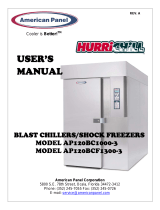
– 8 –
1.1 AUTOMATIC CHILL —
(Controlled by probes, a non-timed chill.) From the main menu, press [1][1].
To begin Automatic Chill, press [YES].
The top row displays the food probe temperatures. The left value
corresponds to the top probe; the right value corresponds to the
bottom probe, etc. The temperature of the air, the AUTO mode
indicator, and the chill cycle time are displayed on the bottom row.
The compressor operates to cool the air down to the selected
blasting air temperature in Chill mode. As each probe reaches the
target temperature in Chill mode, an asterisk (*) displays next to
its temperature display and the buzzer sounds for two minutes or
until the [MUTE] key is pressed. The cycle continues until all
probes have reached the target temperature.
If you press the [STOP] key during a chill cycle, the display at left
allows you to press [YES] and return to the main menu.
When the Automatic Chill ends, buzzer sounds for two minutes.
Pressing [YES] returns to the main menu. If you do not press
[YES] within two minutes, the cabinet goes to Cooler Hold mode.
1.2MANUAL CHILL —
(Timed chill cycle.) From the main menu, press [1] [2].
If the chill time setting is OK, press [YES] to begin. If you want to
reset the chill time, press [CLEAR].
Enter the chill time as a pair of two-digit numbers (HH:MM) where
HH=hours and MM=minutes. Use a leading zero for single digit
numbers. Press [YES].
If the chill time setting is OK, press [YES] to begin.
The top row displays the food probe temperatures. The temperature
of the air, the MANUAL mode indicator, and the countdown time
are displayed on the bottom row. The compressor operates to
cool the air down to the selected blasting air temperature in Chill
mode. As each probe reaches the target temperature in Chill
mode, an asterisk (*) displays next to its temperature display and
the buzzer pulses two seconds on, two seconds off for two
minutes. The Chill cycle continues until the set time has elapsed.
If you press the [STOP] key during a chill cycle, the display at left
allows you to press [YES] and return to the main menu.
When the Manual Chill ends, the buzzer sounds for two minutes.
Pressing [YES] returns to the main menu. If you do not press
[YES] within two minutes, the cabinet goes to Hold mode.
NOTE: For better performance, precool the cabinet by operating in Hold mode prior to loading
product.
A message displays, ERR, when the probe needs to be replaced or when its temperature
is out of range.
AUTOMATIC CHILL
OK TO START [YES/NO]
CHILL CYCLE STOPPED
REMOVE FOOD [YES]
READY TO CHILL FOR
01 HOURS 10 MINUTES?
ENTER NEW CHILL TIME
00 HOURS 00 MINUTES?
READY TO CHILL FOR
00 HOURS 45 MINUTES?
54 58 65
AIR=35 MAN 01:09:59
CHILL CYCLE DONE
REMOVE FOOD [YES]
34 45 37
AIR=25 AUTO 01:25:45
Top
Probe
Bottom
Probe
CHILL CYCLE STOPPED
REMOVE FOOD [YES]
CHILL CYCLE DONE
REMOVE FOOD [YES]















